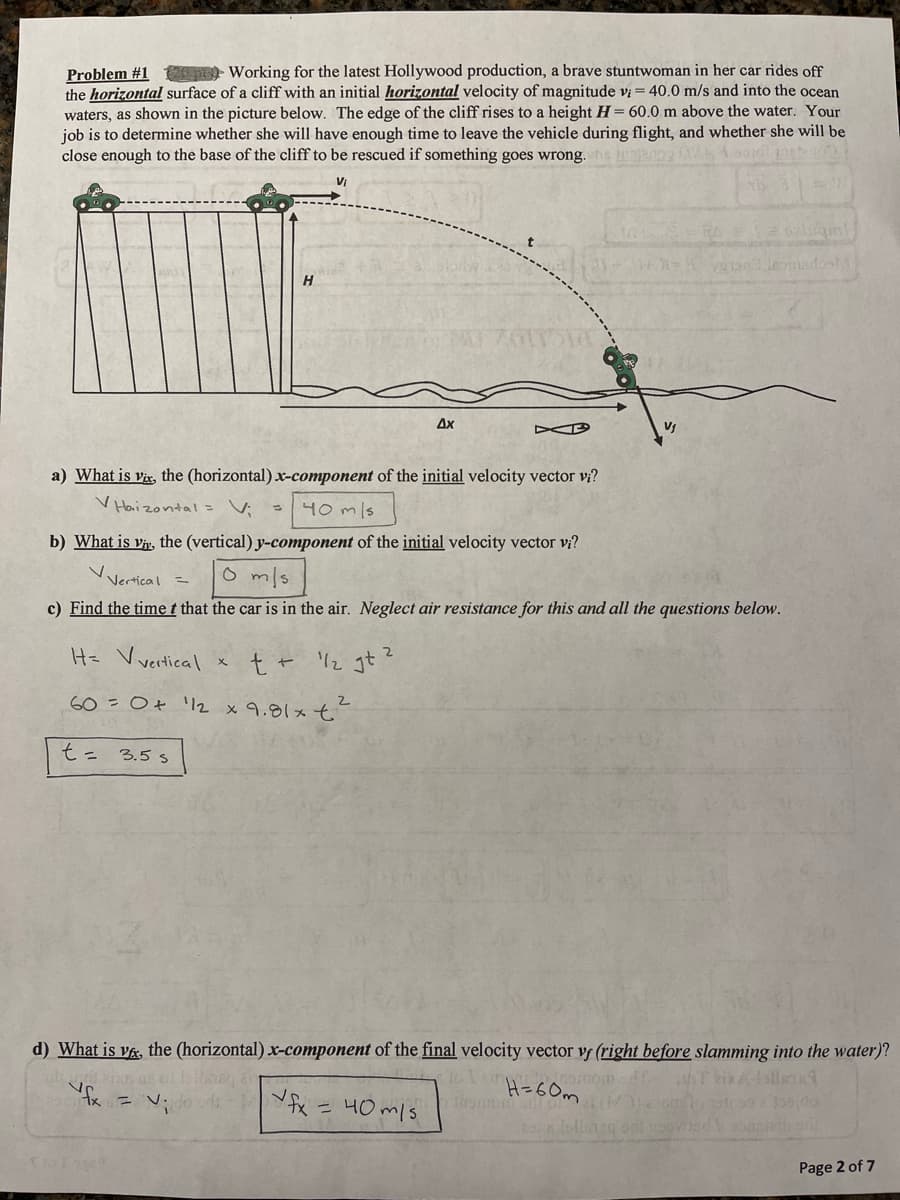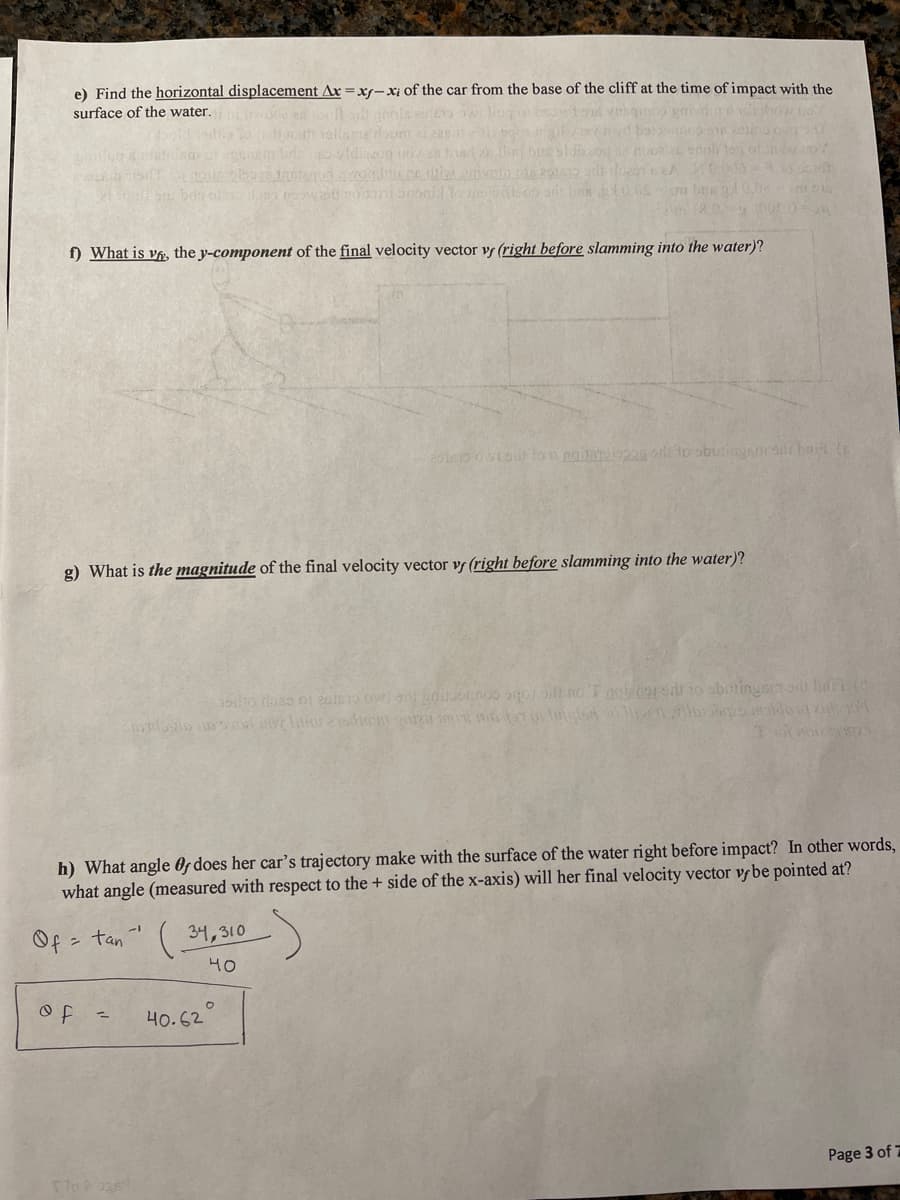Problem #1 Working for the latest Hollywood production, a brave stuntwoman in her car rides off the horizontal surface of a cliff with an initial horizontal velocity of magnitude v = 40.0 m/s and into the ocean waters, as shown in the picture below. The edge of the cliff rises to a height H= 60.0 m above the water. Your job is to determine whether she will have enough time to leave the vehicle during flight, and whether she will be close enough to the base of the cliff to be rescued if something goes wrong. s 9 0
Problem #1 Working for the latest Hollywood production, a brave stuntwoman in her car rides off the horizontal surface of a cliff with an initial horizontal velocity of magnitude v = 40.0 m/s and into the ocean waters, as shown in the picture below. The edge of the cliff rises to a height H= 60.0 m above the water. Your job is to determine whether she will have enough time to leave the vehicle during flight, and whether she will be close enough to the base of the cliff to be rescued if something goes wrong. s 9 0
College Physics
11th Edition
ISBN:9781305952300
Author:Raymond A. Serway, Chris Vuille
Publisher:Raymond A. Serway, Chris Vuille
Chapter3: Motion In Two Dimensions
Section: Chapter Questions
Problem 39AP: A rocket is launched at an angle of 53.0 above the horizontal with an initial speed of 100. m/s. The...
Related questions
Question
Please complete parts E,F and G. Show all work and circle your answers.

Transcribed Image Text:Problem #1 - Working for the latest Hollywood production, a brave stuntwoman in her car rides off
the horizontal surface of a cliff with an initial horizontal velocity of magnitude vi = 40.0 m/s and into the ocean
waters, as shown in the picture below. The edge of the cliff rises to a height H= 60.0 m above the water. Your
job is to determine whether she will have enough time to leave the vehicle during flight, and whether she will be
close enough to the base of the cliff to be rescued if something goes wrong.
Ax
a) What is vix, the (horizontal) x-component of the initial velocity vector v;?
V Haizontal = V;
40 mls
b) What is vi, the (vertical) y-component of the initial velocity vector vị?
o mls
Vertical =
c) Find the time t that the car is in the air. Neglect air resistance for this and all the questions below.
H= Vvertical
t + 2 gt?
60- Ot '2 x9.81メt
t= 3.5s
d) What is v&, the (horizontal) x-component of the final velocity vector vf (right before slamming into the water)?
H=6 0m
こ V:
fx =40 m/s
Page 2 of 7

Transcribed Image Text:e) Find the horizontal displacement Ax =xs-xi of the car from the base of the cliff at the time of impact with the
surface of the water.
f) What is vf, the y-component of the final velocity vector v (right before slamming into the water)?
tovo lon noie to sbutingmddi bai (
g) What is the magnitude of the final velocity vector v (right before slamming into the water)?
h) What angle Of does her car's trajectory make with the surface of the water right before impact? In other words,
what angle (measured with respect to the + side of the x-axis) will her final velocity vector vr be pointed at?
Of = tan -
34, 310)
40
40.62
Page 3 of 7
Expert Solution
Step 1
Given,
Initial horizontal velocity,
Height of the cliff, H=60 m
(e.) Let us consider the horizontal distance travelled from the base of the cliff be x .
By equation of kinematics we have,
.......(1)
The time taken to reach the water from the cliff is
We know there is no acceleration in horizontal direction,
so
Thus equation (1) implies,
Thus, the horizontal distance travelled by the car before slamming the water is 140 m
Step 2
(f.) Initially the y-component of velocity is
Let be the y-component of final velocity
By equation of kinematics,
The y-component of final velocity before slamming the water is 34.29 m/s.
Step by step
Solved in 4 steps

Knowledge Booster
Learn more about
Need a deep-dive on the concept behind this application? Look no further. Learn more about this topic, physics and related others by exploring similar questions and additional content below.Recommended textbooks for you

College Physics
Physics
ISBN:
9781305952300
Author:
Raymond A. Serway, Chris Vuille
Publisher:
Cengage Learning

University Physics Volume 1
Physics
ISBN:
9781938168277
Author:
William Moebs, Samuel J. Ling, Jeff Sanny
Publisher:
OpenStax - Rice University

College Physics
Physics
ISBN:
9781285737027
Author:
Raymond A. Serway, Chris Vuille
Publisher:
Cengage Learning

College Physics
Physics
ISBN:
9781305952300
Author:
Raymond A. Serway, Chris Vuille
Publisher:
Cengage Learning

University Physics Volume 1
Physics
ISBN:
9781938168277
Author:
William Moebs, Samuel J. Ling, Jeff Sanny
Publisher:
OpenStax - Rice University

College Physics
Physics
ISBN:
9781285737027
Author:
Raymond A. Serway, Chris Vuille
Publisher:
Cengage Learning

Principles of Physics: A Calculus-Based Text
Physics
ISBN:
9781133104261
Author:
Raymond A. Serway, John W. Jewett
Publisher:
Cengage Learning